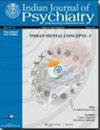Bipolar affective disorder in India: A multi-site population-based cross-sectional study
IF 1.7
4区 医学
Q3 PSYCHIATRY
Indian Journal of Psychiatry
Pub Date : 2023-12-01
DOI:10.4103/indianjpsychiatry.indianjpsychiatry_838_23
引用次数: 0
Abstract
Bipolar Affective Disorder (BPAD) merits careful consideration within the medical and healthcare communities, researchers, and policymakers. This is due to its substantial disability burden, elevated prevalence of co-morbidities, heightened lifetime risk of suicidality, and a significant treatment gap. This article focuses on the lifetime and current prevalence, correlates, co-morbidities, associated disabilities, socio-economic impact, and treatment gap for BPAD in the adult population of the National Mental Health Survey (NMHS) 2016. The NMHS 2016 was a nationally representative study conducted across 12 Indian states between 2014 and 2016. A multi-stage, stratified, random cluster sampling technique based on probability proportionate to size at each stage was used. The diagnosis of BPAD was based on Mini-International Neuropsychiatric Interview 6.0.0. Sheehan's Disability Scale was used to assess the disability. A total of 34,802 adults were interviewed. The overall weighted prevalence of BPAD was 0.3% [95% confidence interval (CI): 0.29–0.31] for current and 0.5% (95% CI: 0.49–0.51) for lifetime diagnosis. Male gender [odds ratio (OR) 1.56] and residence in urban metropolitans (OR 2.43) had a significantly higher risk of a lifetime diagnosis of BPAD. Substantial cross-sectional co-morbidities were noted as per MINI 6.0.0 with the diagnosis of current BPAD such as tobacco use disorder (33.3%), other substance use disorders (14.6%), and anxiety disorders (10.4%). Two-thirds of persons with current BPAD reported disability of varying severity at work (63%), social (59.3%), and family life (63%). The treatment gap for current BPAD was 70.4%. Most individuals with current BPAD reported moderate–severe disability. There were substantial co-morbidities and a large treatment gap. These warrant concentrated efforts from policymakers in devising effective strategies.印度的躁郁症:一项多地点人群横断面研究
双相情感障碍(BPAD)值得医学界、卫生界、研究人员和政策制定者仔细考虑。这是由于其严重的残疾负担、较高的合并症患病率、较高的终生自杀风险以及显著的治疗缺口。本文主要关注2016年国家心理健康调查(NMHS)中成年人群中BPAD的终生和当前患病率、相关性、合并症、相关残疾、社会经济影响和治疗差距。NMHS 2016是2014年至2016年在印度12个邦进行的一项具有全国代表性的研究。采用多阶段、分层、随机聚类抽样技术,每个阶段采用与规模成概率比例的抽样方法。BPAD的诊断基于Mini-International神经精神病学访谈6.0.0。采用Sheehan's残疾量表对残疾进行评定。共有34802名成年人接受了采访。目前BPAD的总加权患病率为0.3%[95%可信区间(CI): 0.29-0.31],终身诊断为0.5% (95% CI: 0.49-0.51)。男性[比值比(OR) 1.56]和居住在城市大都市(OR 2.43)终生诊断为BPAD的风险显著高于男性。根据MINI 6.0.0,大量横断面合并症与当前BPAD的诊断有关,如烟草使用障碍(33.3%),其他物质使用障碍(14.6%)和焦虑症(10.4%)。三分之二的BPAD患者报告在工作(63%)、社交(59.3%)和家庭生活(63%)中存在不同程度的残疾。目前BPAD的治疗缺口为70.4%。大多数BPAD患者报告有中度至重度残疾。有大量的合并症和很大的治疗差距。这需要决策者集中精力制定有效的战略。
本文章由计算机程序翻译,如有差异,请以英文原文为准。
求助全文
约1分钟内获得全文
求助全文
来源期刊

Indian Journal of Psychiatry
Medicine-Psychiatry and Mental Health
CiteScore
4.40
自引率
3.20%
发文量
130
审稿时长
34 weeks
期刊介绍:
The Indian Journal of Psychiatry (ISSN 0019-5545), is an official publication of the Indian Psychiatric Society. It is published Bimonthly with one additional supplement (total 5 issues). The IJP publishes original work in all the fields of psychiatry. All papers are peer-reviewed before publication.
The issues are published Bimonthly. An additional supplement is also published annually. Articles can be submitted online from www.journalonweb.com . The journal provides immediate free access to all the published articles. The journal does not charge the authors for submission, processing or publication of the articles.
 求助内容:
求助内容: 应助结果提醒方式:
应助结果提醒方式:


